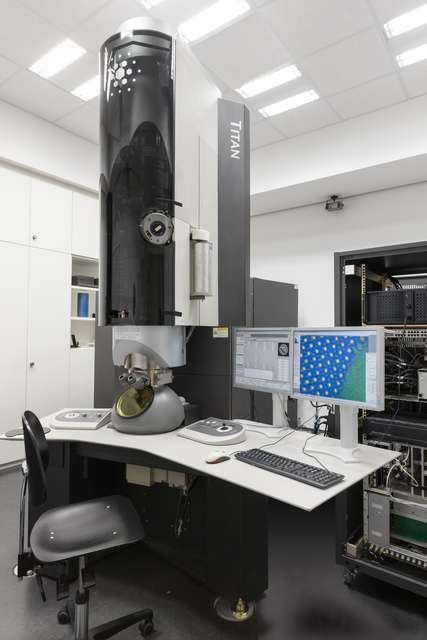FEI Titan 80-300 TEM (Titan T)
Jülich
The FEI Titan 80-300 TEM is a high-resolution transmission electron microscope equipped with a field emission gun and a corrector for the spherical aberration (CS) of the imaging lens system. The instrument is designed for the investigation of a wide range of solid state phenomena taking place on the atomic scale, which requires true atomic resolution capabilities. Under optimum optical settings of the image CS-corrector (CEOS CETCOR) the point-resolution is extended up to the information limit of well below 100 pm with 200 keV and 300 keV electrons. A special piezo-stage design allows ultra-precise positioning of the specimen in all 3 dimensions. Digital images are acquired with a Gatan 2k x 2k slow-scan charged coupled device camera.
Typical Applications and Limitations of Use
The configuration of the FEI Titan 80-300 TEM is dedicated to provide optimum performance for high-resolution transmission electron microscopy imaging techniques to be applied to solid state materials. The typical setup used for high-resolution transmission electron microscopy (HRTEM) imaging involves an intentional over-compensation of the intrinsically positive spherical aberration of the objective lens towards a total negative spherical aberration of the imaging system. The negative spherical-aberration imaging (NCSI) technique provides maximum contrast transfer up to the information limit of the instrument yielding bright-atom contrast. The NCSI technique enables on the one hand a more intuitive interpretation of HRTEM images in terms of direct structure projections of e.g. structural defects and interfaces. On the other hand, the superior image contrast at minimum delocalisation allows one to quantify individual atomic displacements with picometre precision from a single image to study for example local electric polarisation phenomena. A further technique applied with this instrument is the reconstruction of the electron wave function based on a focal series of HRTEM images, which allows one to eliminate nonlinear contrast artifacts and residual imaging aberrations from the experimental data.
The FEI Titan 80-300 TEM is not intended for the investigation of aqueous, contaminated, ferromagnetic or organic samples without further discussions with both of the instruments officers and the ER-C general management.
Sample Environment
Apart from the special case of the utilisation of dedicated cooling or heating stages, the FEI Titan 80-300 TEM will allow samples to be investigated either under room temperature or liquid nitrogen cooling conditions at a vacuum level of about 10–8 mbar. Besides this standard setup, the sample environment can be adapted to various conditions, e.g. the thermal treatment or the application of external electric or magnetic fields to samples, making use of a wide portfolio of in situ TEM holders available through the ER-C user services.
Publications
Determination of the 3D shape of a nanoscale crystal with atomic resolution from a single image
Jia C, Mi S, Barthel J, Wang D, Dunin-Borkowski R, Urban K, Thust A - Nature Materials - 2014
On the optical stability of high-resolution transmission electron microscopes
Barthel J, Thust A - Ultramicroscopy - 2013
On the benefit of the negative-spherical-aberration imaging technique for quantitative HRTEM
Jia C, Houben L, Thust A, Barthel J - Ultramicroscopy - 2010
Aberration measurement in HRTEM: Implementation and diagnostic use of numerical procedures for the highly precise recognition of diffractogram patterns
Barthel J, Thust A - Ultramicroscopy - 2010
Quantification of the Information Limit of Transmission Electron Microscopes
Barthel J, Thust A - Physical Review Letters - 2008
Numerical correction of lens aberrations in phase-retrieval HRTEM
Thust A, Overwijk M, Coene W, Lentzen M - Ultramicroscopy - 1996
Link: https://er-c.org/index.php/access/
